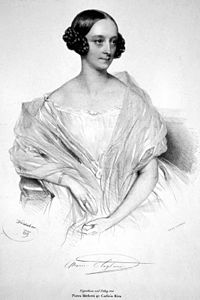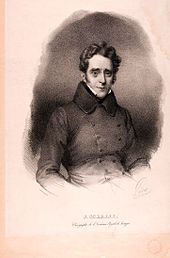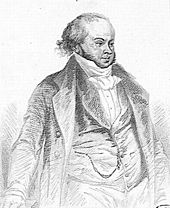414:
360:
31:
319:
916:
271:
230:. Their aim is to seduce the knight, Robert le Diable, into accepting a talisman to win him a princess. At the end of the ballet, the white-clad nuns return to their tombs. The ballet was created (in part) to demonstrate the building's newly installed gas lighting. The lighting was capable of creating ghastly effects.
435:
Critic and dance historian Andre
Levinson writes, "The academic dance had been an agreeable exercise to watch. Now, clarified matters of the soul. Ballet was a divertissement (an entertainment, a distraction). It became a mystery." Kisselgoff writes, "... the preoccupation with the supernatural that
286:
however was something entirely new in concept to audiences on the ballet's opening night. Henri
Duponchel, managing director of the Paris Opéra, was in charge of visual effects at the Opéra. He wanted to demonstrate the venue's recently installed gas lighting. Its reflectors produced a stronger, more
431:
wrote, "The diabolical music and the dead rising from their tombs and the terrible darkness and the strange dance unite to form a stage effect almost unrivaled. The famous witches' (nuns) dance in the freezing moonlight in the ruined abbey, was as impressive as expected ... They drop in like flakes
394:
about a dozen times. She left after six. It is possible that the erotic implications of the nuns' ballet did not set well with her. She may have been reluctant to appear in a ballet within an opera. A foot injury and the accidents that marred the first performance may have given the ballerina pause
354:
A crowd of mute shades glides though the arches. All these women cast off their nuns' costume, they shake off the cold powder of the grave; suddenly they throw themselves into the delights of their past life; they dance like bacchantes, they play like lords, they drink like sappers. What a pleasure
309:
included the scene in one of his novels. Andersen writes of the scene, "By the hundred they rise from the graveyard and drift into the cloister. They seem not to touch the earth. Like vaporous images, they glide past one another ... Suddenly their shrouds fall to the ground. They stand in all their
253:
Robert enters. The nuns hide, but return to prevent his escape. Robert stands terrified before a saint's tomb. The Abbess lures him towards the talisman in the saint's hand. Robert seizes it. The nuns continue their dance, fluttering like white moths. Their graves open and they sink into the earth.
326:
Opening night was spoiled by a falling gaslight and a trapdoor that would not close properly. A piece of scenery fell, narrowly missing
Taglioni. The curtain was brought down. The ballerina assured everyone she was unharmed. The curtain rose and the performance continued. It ended in a triumph for
266:
however ushered in a period that brought romantic ballet to the stage. Trapdoors, gas lighting, and other elements that became associated with the romantic ballet had been used in the popular theaters on the Paris boulevards for some time. Such elements would gain official sanction and prestige at
249:
The ballet opens with
Bertram, Robert le Diable's father, entering the ruined cloister of Sainte-Rosalie. He summons the ghosts of nuns who have violated their vows. They rise from their graves. He orders them to seduce his son Robert into accepting a deadly talisman. The Abbess Helena orders the
413:
298:
Europe rather than the classical world of Greece and Rome. After almost 100 years of rational thought, audiences were clamoring for the mysterious, the supernatural, the vague, and the doomed. The story of the ballet is about a knight who slips into a cloister at midnight to steal a
240:
as the Abbess Helena. Although opening night was marred with a few mishaps, Taglioni made her indelible mark on the ballet world in the role. She became known for her ethereal qualities and her moral purity, and is one of the most celebrated ballerinas in history.
359:
939:
291:, chief scenery designer. Ciceri was inspired by either the Saint-Trophime cloister in Arles or the cloister of Monfort-l'Amaury for the ballet's moonlit setting.
334:
a year. Her father was named ballet master with a three-year contract. Véron's boldness was rewarded when
Taglioni fulfilled her promise and became a great star.
330:
Dr. Véron had recently been awarded the Paris Opéra as a private enterprise. He had great faith in
Taglioni. He raised her salary to an unprecedented 30,000
758:
944:
708:
310:
voluptuous nakedness, and there begins a bacchanal." The nuns were not completely naked, but
Andersen did capture the essence of the scene.
648:
919:
806:
695:
673:
751:
949:
410:
between 1843 and 1863, on this. His choreography has been fully preserved. It represents the only record of the original.
250:
ghosts to waltz. In spite of their sacred vows, the nuns waltz. The dead nuns give themselves over to unholy thrills.
868:
744:
424:
432:
of snow and are certainly very charming witches with their jaunty
Parisian figures and most refined pirouettes."
294:
The theme of the ballet is passion and death, and love beyond the grave. The scene is night rather than day, and
288:
406:
saw
Fitzjames's performance as the Abbess in Paris in 1841. He based his own choreography, which was used in
395:
for thought. Bad press directed at her father may have caused
Taglioni to withdraw. Taglioni was replaced by
306:
383:. The opera was performed 756 times between 1831 and 1893 at the Paris Opéra. French Impressionist painter
884:
838:
830:
822:
102:
428:
403:
790:
782:
767:
691:
669:
644:
263:
186:
52:
846:
814:
396:
208:
195:
62:
704:
380:
182:
162:
30:
318:
900:
876:
684:
237:
200:
144:
90:
933:
860:
436:
characterized so much of 19th-century ballet could be traced to the success of the
375:
212:
204:
177:
384:
262:
Ballet of the 18th century was based on rational thought and classical art. The
190:
407:
295:
254:
Stone slabs slide into place, covering the dead. A choir of demons is heard.
282:
theme was danced in Paris before Her Highness Mlle de Longueville in 1652.
270:
300:
227:
327:
Meyerbeer, the Taglionis, and Dr. Louis Véron, the Opéra's new manager.
892:
331:
736:
412:
358:
317:
269:
303:
from a dead saint's hand that will allow him to win a princess.
223:
740:
387:
painted the ballet scene several times between 1871 and 1876.
219:
287:
keenly directed light than ever before. Working with him was
16:
Episode in Giacomo Meyerbeer's grand opera, Robert le diable
267:
the Paris Opéra in the middle decades of the 19th century.
440:
in Meyerbeer's first production at the Paris Opéra".
342:
The audience took prurient delight in the scandalous
774:
158:
150:
140:
132:
122:
108:
98:
82:
68:
58:
48:
40:
23:
683:
686:Four Centuries of Ballet : Fifty Masterworks
199:. It was first performed in November 1831 at the
709:"Romantic Ballet began in an Opera by Meyerbeer"
390:Under her contract, Taglioni was to appear in
215:may have choreographed the entry of the nuns.
752:
8:
73:
940:Ballets premiered at the Paris Opera Ballet
915:
759:
745:
737:
665:Meyerbeer und das europäische Musiktheater
479:
20:
623:
611:
730:The Spectacle of the Past in Grand Opera
587:
574:
550:
538:
525:
513:
501:
460:
448:
569:
567:
565:
563:
561:
559:
497:
495:
493:
491:
489:
487:
475:
473:
471:
469:
456:
454:
452:
599:
7:
75:Quarante miracles dits de Notre-Dame
218:The short ballet tells of deceased
14:
945:Compositions by Giacomo Meyerbeer
668:, Laaber-Verlag, pp. 73–86,
643:, Dance Books, pp. 201–210,
399:, who danced the role 232 times.
914:
136:Sainte-Rosalie Cloister in ruins
29:
732:, in Charlton (2003), pp. 58–75
185:. It is an episode in Act 3 of
659:The "Ballet of the Nuns" from
1:
721:A Queer History of the Ballet
657:Jürgenson, Knud Arne (1998),
690:, Dover Publications, Inc.,
641:The Romantic Ballet in Paris
723:, Routledge, pp. 24–25
966:
869:Ein Feldlager in Schlesien
682:Kirstein, Lincoln (1984),
425:Henry Wadsworth Longfellow
274:Jean Coralli, date unknown
207:(now lost) was created by
911:
402:The Danish choreographer
355:to see these light women.
289:Pierre-Luc-Charles Ciceri
28:
728:Williams, Simon (2003),
719:Stoneley, Peter (2007),
807:Semiramide riconosciuta
307:Hans Christian Andersen
99:Original ballet company
794:(1813) (also known as
421:
367:
357:
323:
275:
74:
950:1831 ballet premieres
839:Il crociato in Egitto
663:and its Revival", in
416:
362:
352:
348:Revue des Deux-Mondes
346:. A reviewer for the
321:
273:
707:(December 2, 1984),
639:Guest, Ivor (2008),
417:Ciceri's design for
35:Marie Taglioni, 1839
528:, pp. 142–143.
404:August Bournonville
853:Ballet of the Nuns
831:L'esule di Granata
823:Margherita d'Anjou
791:Die beiden Kalifen
713:The New York Times
438:Ballet of the Nuns
422:
419:Ballet of the Nuns
368:
366:at the Paris Opéra
364:Ballet of the Nuns
324:
284:Ballet of the Nuns
276:
234:Ballet of the Nuns
222:rising from their
172:Ballet of the Nuns
154:Gothic Romanticism
103:Paris Opéra Ballet
24:Ballet of the Nuns
927:
926:
768:Giacomo Meyerbeer
626:, pp. 78–79.
264:French Revolution
187:Giacomo Meyerbeer
168:
167:
116:Helena, an Abbess
53:Giacomo Meyerbeer
957:
918:
917:
885:L'étoile du nord
847:Robert le diable
815:Emma di Resburgo
761:
754:
747:
738:
733:
724:
715:
705:Kisselgoff, Anna
700:
689:
678:
661:Robert le diable
653:
650:978-185273-119-9
627:
621:
615:
609:
603:
597:
591:
584:
578:
571:
554:
548:
542:
541:, pp. 22–23
535:
529:
523:
517:
511:
505:
499:
482:
477:
464:
458:
397:Louise Fitzjames
280:Robert le Diable
209:Filippo Taglioni
196:Robert le diable
114:Robert le Diable
94:
93:
87:22 November 1831
77:
44:Filippo Taglioni
33:
21:
965:
964:
960:
959:
958:
956:
955:
954:
930:
929:
928:
923:
907:
783:Jephtas Gelübde
770:
765:
727:
718:
703:
698:
681:
676:
656:
651:
638:
635:
630:
622:
618:
610:
606:
598:
594:
585:
581:
572:
557:
549:
545:
536:
532:
524:
520:
512:
508:
500:
485:
480:Kisselgoff 1984
478:
467:
459:
450:
446:
427:'s future wife
381:romantic ballet
340:
316:
260:
247:
183:romantic ballet
163:Romantic ballet
127:
126:Henri Duponchel
117:
115:
113:
89:
88:
86:
36:
17:
12:
11:
5:
963:
961:
953:
952:
947:
942:
932:
931:
925:
924:
920:List of operas
912:
909:
908:
906:
905:
897:
889:
881:
873:
865:
857:
843:
835:
827:
819:
811:
803:
796:wirth und Gast
787:
778:
776:
772:
771:
766:
764:
763:
756:
749:
741:
735:
734:
725:
716:
701:
696:
679:
674:
654:
649:
634:
631:
629:
628:
624:Jürgenson 1998
616:
612:Jürgenson 1998
604:
602:, p. 205.
592:
579:
555:
543:
530:
518:
516:, p. 142.
506:
483:
465:
447:
445:
442:
429:Fanny Appleton
379:and the first
373:was the first
339:
336:
315:
312:
278:A ballet on a
259:
256:
246:
243:
238:Marie Taglioni
181:and the first
166:
165:
160:
156:
155:
152:
148:
147:
145:Marie Taglioni
142:
138:
137:
134:
130:
129:
124:
120:
119:
118:Ghosts of Nuns
110:
106:
105:
100:
96:
95:
84:
80:
79:
70:
66:
65:
60:
56:
55:
50:
46:
45:
42:
38:
37:
34:
26:
25:
15:
13:
10:
9:
6:
4:
3:
2:
962:
951:
948:
946:
943:
941:
938:
937:
935:
922:
921:
910:
903:
902:
898:
895:
894:
890:
887:
886:
882:
879:
878:
874:
871:
870:
866:
863:
862:
861:Les Huguenots
858:
855:
854:
849:
848:
844:
841:
840:
836:
833:
832:
828:
825:
824:
820:
817:
816:
812:
809:
808:
804:
801:
797:
793:
792:
788:
785:
784:
780:
779:
777:
773:
769:
762:
757:
755:
750:
748:
743:
742:
739:
731:
726:
722:
717:
714:
710:
706:
702:
699:
697:0-486-24631-0
693:
688:
687:
680:
677:
675:3-89007-410-3
671:
667:
664:
660:
655:
652:
646:
642:
637:
636:
632:
625:
620:
617:
614:, p. 76.
613:
608:
605:
601:
596:
593:
589:
588:Williams 2003
583:
580:
577:, p. 143
576:
575:Kirstein 1984
570:
568:
566:
564:
562:
560:
556:
553:, p. 23.
552:
551:Stoneley 2007
547:
544:
540:
539:Stoneley 2007
534:
531:
527:
526:Kirstein 1984
522:
519:
515:
514:Kirstein 1984
510:
507:
504:, p. 142
503:
502:Kirstein 1984
498:
496:
494:
492:
490:
488:
484:
481:
476:
474:
472:
470:
466:
462:
461:Stoneley 2007
457:
455:
453:
449:
443:
441:
439:
433:
430:
426:
420:
415:
411:
409:
405:
400:
398:
393:
388:
386:
382:
378:
377:
372:
365:
361:
356:
351:
349:
345:
337:
335:
333:
328:
320:
314:Opening night
313:
311:
308:
304:
302:
297:
292:
290:
285:
281:
272:
268:
265:
257:
255:
251:
244:
242:
239:
235:
231:
229:
225:
221:
216:
214:
210:
206:
202:
198:
197:
192:
188:
184:
180:
179:
175:is the first
174:
173:
164:
161:
157:
153:
149:
146:
143:
139:
135:
131:
128:Pierre Ciceri
125:
121:
111:
107:
104:
101:
97:
92:
85:
81:
78:
76:
71:
67:
64:
63:Eugène Scribe
61:
57:
54:
51:
47:
43:
41:Choreographer
39:
32:
27:
22:
19:
913:
899:
891:
883:
875:
867:
859:
852:
851:
845:
837:
829:
821:
813:
805:
799:
795:
789:
781:
729:
720:
712:
685:
666:
662:
658:
640:
619:
607:
595:
590:, p. 71
582:
546:
533:
521:
509:
463:, p. 22
437:
434:
423:
418:
401:
391:
389:
376:ballet blanc
374:
370:
369:
363:
353:
347:
343:
341:
329:
325:
305:
293:
283:
279:
277:
261:
252:
248:
233:
232:
226:in a ruined
217:
213:Jean Coralli
205:choreography
194:
178:ballet blanc
176:
171:
170:
169:
72:
18:
901:L'Africaine
877:Le prophète
385:Edgar Degas
322:Louis Véron
201:Paris Opéra
191:grand opera
141:Created for
91:Paris Opéra
934:Categories
633:References
600:Guest 2008
573:Quoted in
537:Quoted in
408:Copenhagen
258:Background
109:Characters
586:Cited in
338:Reception
850:(1831) (
800:Alimelek
301:talisman
236:starred
228:cloister
83:Premiere
69:Based on
59:Libretto
893:Dinorah
133:Setting
112:Bertram
904:(1865)
896:(1859)
888:(1854)
880:(1849)
872:(1844)
864:(1836)
842:(1824)
834:(1822)
826:(1820)
818:(1819)
810:(1819)
786:(1812)
775:Operas
694:
672:
647:
350:wrote:
332:francs
296:Gothic
203:. The
123:Design
444:Notes
245:Story
224:tombs
151:Genre
49:Music
798:and
692:ISBN
670:ISBN
645:ISBN
392:Nuns
371:Nuns
344:Nuns
220:nuns
159:Type
189:'s
936::
711:,
558:^
486:^
468:^
451:^
211:.
193:,
856:)
802:)
760:e
753:t
746:v
Text is available under the Creative Commons Attribution-ShareAlike License. Additional terms may apply.



